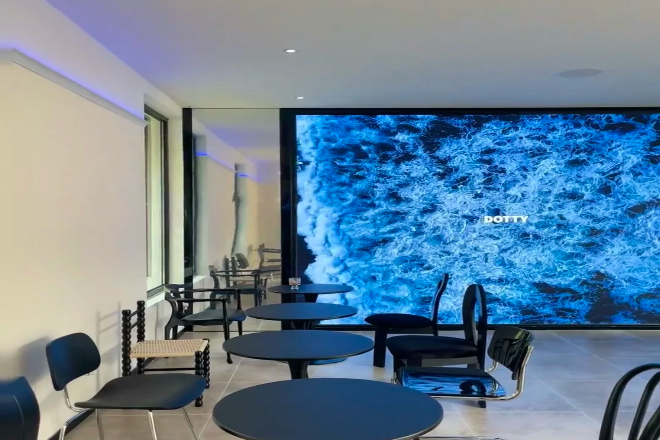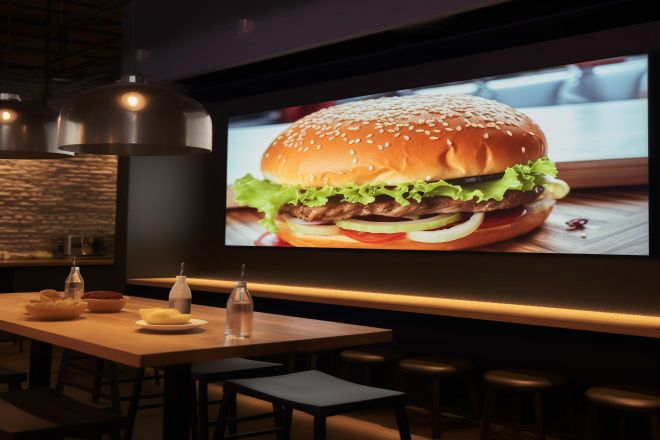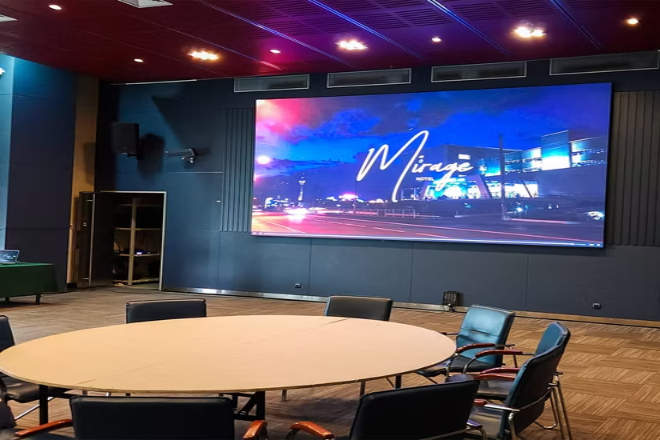소개
In today’s era, where appearance is more important, the appearance of a restaurant does not rely only on decoration.
발광 다이오드 표시 스크린 have long become the “face” to attract customers. However, this screen is not just installed casually. It must withstand the high temperature and fumes in the kitchen, display the food pictures, and even “interact” with customers.
So, how should restaurants choose to use LED display screens to make them both beautiful and easy to use without any trouble? Don’t worry, let’s take a look together.
목차
Requirement 1: Environmental adaptability requirements

In the small world of restaurants full of food and fireworks, LED display screens cannot be as picky about the environment as delicate guests.
It must be like a “tough guy” who can adapt to various environmental changes in order to “stand” firmly in its post.
First of all, temperature changes are a common “episode” in restaurants. In summer, when the air conditioner is turned on, the cold air blows; in winter, when the heating comes on, it is steaming.
Coupled with the occasional heat from the kitchen, the temperature changes are like a roller coaster.
Therefore, the LED display screen must have a “good body” and can work normally in the temperature range of 0℃ to 55℃. However, to be on the safe side, it is best to control the temperature below 40℃ so that the display screen can operate in a comfortable environment.
Moreover, the display screen itself must be able to “perspire” and have good heat dissipation performance.
Otherwise, it will “get heatstroke” when the internal temperature is high; not only will the display effect deteriorate, but the life span will also be greatly reduced.
In terms of humidity, the moisture in the restaurant kitchen is no joke. If the display screen is not moisture-proof and waterproof, the internal electronic components will be “soaked” in minutes.
Therefore, it has to wear a “protective suit” with a protection level of at least IP30 to IP50 to resist the invasion of moisture.
If you encounter a “sauna day” with extremely high humidity, you have to equip it with a “little helper,” such as a desiccant and a heater, or simply protect it with a sealed structure.
Lighting conditions are also critical. The light in the restaurant is soft, and if the display screen is too bright, the customer’s eyes will suffer.
Therefore, the display screen must be able to “change its face” and automatically or manually adjust the brightness according to the ambient light, just like a caring “light-sensing elf,” which can glow in the dark and not be dazzling in the bright.
Moreover, no matter what the light is, it must restore the color to its “original flavor,” making the dishes look more tempting and the advertising more attractive.
Dust and oil smoke are also the “natural enemies” of the display screen. In the restaurant, various particles are floating in the air. If the display screen is not dustproof, the surface will soon become “dusty,” and the display effect will be greatly reduced.
Therefore, it must have a “dust shield” with a protection level of at least IP50 to keep dust out.
At the same time, its surface must be easy to clean, just like a clean child, and it can be restored to its bright and beautiful appearance by wiping it regularly.
Finally, anti-interference and safety cannot be ignored. There are many electrical appliances in the restaurant, and electromagnetic interference is common.
The display screen must have a “copper wall and iron wall” to resist these interferences. Otherwise, it will be a joke if the display effect is messed up.
Moreover, its electrical system must meet safety standards, have overcurrent, overvoltage, and Undervoltage protection, and a grounding device, just like fastening a “seat belt” to it to ensure that it is foolproof.
In short, the LED display screen in the restaurant must be like an “all-round warrior”, which can be stable and shining in various complex environmental conditions, adding luster to the restaurant and making customers shine.
Requirement 2: Requirements for visual effects and content adaptation
In the restaurant, a small world full of food temptations, the LED display screen must not only be a “tough guy” but also a “face value” and “content expert.”
It must use gorgeous pictures and appropriate content to attract customers as soon as they enter the door as if they have entered a fantasy world of food.
The atmosphere in the restaurant is comfortable and cozy, so the picture of the LED display screen cannot be too “overshadowing.”
It must be like an elegant “artist,” using just the right 명도 and color to show a mouth-watering food picture.
Imagine a steak sizzling on the screen, grilled to perfection, dotted with fresh herbs and vegetables, and colorful enough to smell the aroma.
Such a picture can not only stimulate the taste buds of customers but also make the atmosphere of the entire restaurant more tempting.
그만큼 해결 of the LED display in the restaurant must be high, just like putting a pair of high-definition glasses on the customers. The texture of each grape and the color of each piece of salmon must be clearly visible.
In this way, whether it is displaying signature dishes or introducing the restaurant’s special services, customers can see it clearly, as if those delicacies are right in front of them.
Content adaptation is also very important. The LED display in the restaurant is not a simple billboard; it has to be like a “story king.”
For example, it can play a short video about the history of the restaurant, telling how the restaurant has developed step by step from a small stall and what interesting stories are behind it.
Or show the busy figures of chefs in the kitchen so that customers can feel the hard work and passion behind each dish.
Such content can not only increase customers’ sense of identity with the restaurant but also make them no longer bored while waiting for the dishes to be served.
In addition, the content update of the LED display screen should be as “fresh” as the restaurant’s dishes.
There are new dishes recommended and new promotions every day, and even some customer reviews and feedback can be displayed to let customers feel the restaurant’s dedication and vitality.
Moreover, the style of the content should match the overall style of the restaurant. If the restaurant focuses on romantic French style, the content on the display screen should be full of elegance and art.
If the restaurant is a lively hot pot restaurant, the picture should be full of vitality and enthusiasm.
In short, the LED display screen in the restaurant must be an “all-rounder” that can attract customers’ attention with exquisite visual effects and retain customers’ hearts with appropriate content.
It is like the “face” of the restaurant, allowing every customer who enters the restaurant to feel the unique charm and warm welcome.
Requirement 3: Requirements for content management and interactive functions

1). Content management:
The restaurant’s LED display screen should be like a “content butler,” arranging various information clearly.
First of all, it must be able to easily create, edit, and publish various content, whether it is high-definition pictures, exciting videos, or scrolling text; all can be done with one click.
For example, when a restaurant launches new dishes, the food pictures carefully prepared by the chefs can instantly appear on the screen, making customers’ eyes light up.
Moreover, these contents can be played regularly, such as during the peak hours of lunch and dinner, focusing on displaying signature dishes and promotions to attract customers’ attention.
More importantly, the content of the LED display must be able to update in real-time. Imagine that the restaurant has just launched a limited-time discount package.
Through simple operations, this information can immediately appear on the screen, allowing customers to know for the first time.
This efficiency is not comparable to traditional billboards. At the same time, the content management system must also have a powerful audit function to ensure that every piece of information displayed on the screen is accurate.
2). Interactive function:
The restaurant’s LED display is not just a “big screen”; it is also an “interactive expert.” Through somatosensory recognition and gesture recognition technology, customers can easily interact with the screen, just like playing a game.
For example, at the entrance of the restaurant, an interactive LED screen is set up. When the customer waves his hand, a welcome message will appear on the screen, and even different animation effects can be displayed according to the customer’s actions.
This unique experience can immediately attract the customer’s attention and make them feel that the restaurant is full of technology and fun.
Moreover, the LED display can also be linked with the restaurant’s ordering system.
Customers can easily order food through the touch screen at the table, view detailed information about the dishes, and even customize the dishes, such as asking for less spicy food and more ingredients.
This interaction not only improves the efficiency of ordering but also allows customers to feel the restaurant’s caring service.
In addition, the LED display can also display customer reviews and photos, allowing customers to see other people’s dining experiences and enhance their trust in the restaurant.
You can even set up some interactive games, such as guessing games, lottery activities, etc., so that customers are no longer bored while waiting for the dishes to be served, and can also increase their sense of participation and fun.
In short, the restaurant’s LED display screen can not only improve the restaurant’s operating efficiency through powerful content management and interactive functions but also bring customers a richer and more interesting dining experience, allowing the restaurant to stand out in the fierce market competition.
Requirement 4: Requirements for installation and maintenance convenience
In the restaurant’s small world full of fireworks, the LED display screen must not only be beautiful and fun but also be a very time-saving and labor-saving device.
It must be easy and convenient to install and maintain. After all, restaurant owners don’t have much time to “dawdle” on these things.
1). Installation convenience:
The installation of the restaurant’s LED display screen must be as simple as building Lego. First of all, the choice of installation location is critical.
Generally speaking, the entrance of the restaurant is an excellent location, and customers can be attracted as soon as they enter the door. For example, you can choose a wall-mounted installation.
As long as the wall is strong enough, it can be easily fixed with expansion screws or electric welding.
During the installation process, the bracket must be firm, and the level must be used to ensure that the display screen is flat.
If the restaurant space is limited, the front maintenance LED display screen is a good choice. This display screen can be maintained directly from the front, without the need to reserve a maintenance channel, which greatly saves space.
Moreover, the modular design makes installation easy, just like building blocks, just put them together piece by piece.
2). Maintenance convenience:
Maintaining the LED display screen cannot be as strenuous as taking care of “flowers in a greenhouse.” First of all, regular cleaning is the key.
The surface of the display screen is prone to dust accumulation, which affects the display effect, so it should be wiped regularly with a clean, soft cloth.
If it is an outdoor display screen or if there is a lot of dust, a professional cleaning team may be needed to help.
Inspection is also essential. Regularly check the lamp beads, power supply and circuits to see if there are any aging or damage.
If you find a problem, replace it in time, don’t delay. Moreover, software updates are also very important.
The new version of the software can not only optimize performance, but also fix some minor problems to keep the display screen in the best condition.
In short, the restaurant’s LED display screen must be a “worry-free baby”, easy to install and convenient to maintain.
In this way, restaurant owners can focus more on food and service, so that customers can eat happily and have fun.
Requirement 5: The need for a balance between cost and benefit

In the restaurant, a small world full of fireworks, the LED display cannot be just a “money-burning” decoration.
It must be the “king of cost-effectiveness,” which can not only help the restaurant earn enough face but also bring real benefits.
This requires finding a perfect balance between cost and benefit so that every investment can be “value for money.”
Let’s talk about cost first. Buying an LED display is like buying clothes. You have to choose a “fitting” one. If the size is too large, the wallet can’t bear it; if the resolution is not enough, the picture will be blurry.
Therefore, restaurant owners have to choose the right display according to their “figure” – that is, the size and budget of the restaurant.
If the restaurant focuses on the high-end route, then the high-resolution, large-size display is the “face.” although the price is a bit expensive, it can instantly improve the grade.
If the restaurant takes the people-friendly route, then the cost-effective display is the “king of cost-effectiveness,” which can save money and meet basic needs.
The installation cost must also be calculated. Installation is like decoration. The more complex the location, the higher the cost.
If the display is hung at the entrance of the restaurant, it can be seen at a glance, then the installation is relatively simple, and the cost will not be too high. But if it is hung high in the restaurant, scaffolding will have to be built, and the cost will go up.
Therefore, the installation location must be well planned, which should be both conspicuous and economical.
Operation costs cannot be ignored. Although LED display screens are energy-saving, they are turned on all day long, and the electricity bill is also a considerable expense.
Moreover, the display screen must be cleaned and inspected regularly. Otherwise, the picture will be blurred, and customers will not feel comfortable watching it. Therefore, choose a low-energy, easy-to-maintain display screen to save yourself worry and effort.
Let’s look at the benefits.
A good LED display screen is like a “living sign” for a restaurant, which can attract customers’ attention and enhance the restaurant’s popularity.
Imagine that as soon as customers enter the door, they are attracted by a high-definition, bright display screen, which displays the restaurant’s signature dishes, special services, and attractive promotions.
Who can resist such a picture? Data shows that restaurants that use LED display screens can increase sales by an average of 15%-20%.
This is not a small amount. The extra income may be able to “earn” back the cost of the display screen.
Moreover, LED display screens can help restaurants save a lot of advertising costs.
Traditional billboards are troublesome to update content and the effect is not good. But LED display screens are different.
The content can be updated at any time and can be flexibly adjusted according to the activities of the restaurant. In this way, not only the cost of advertising production is saved, but also the advertising effect can be more direct.
Finally, if the restaurant’s display screen is in a good position and has a large flow of people, you can also consider renting advertising space.
This is like opening a “small advertising space” in the restaurant, which can not only increase additional income, but also make full use of the restaurant’s resources.
In short, the restaurant’s LED display screen must be a “cost-effective king” and find a perfect balance between cost and benefit.
It is necessary to consider both the initial investment and the long-term benefits so that the display screen can truly become a “powerful assistant” for the restaurant and make the restaurant stand out in the fierce market competition.
6. 결론
In general, the LED display screen in the restaurant is not only a “background board” but also a good helper that can “speak,” “attract attention,” and help “business.”
If you choose the right one, install it well, and use it skillfully, it can help you win more customers’ attention and appetite in the fiercely competitive catering market. So, don’t treat it as a decoration; treat it as a partner!
마지막으로 LED 디스플레이에 대해 더 알고 싶으시다면, 우리에게 연락해주세요.
